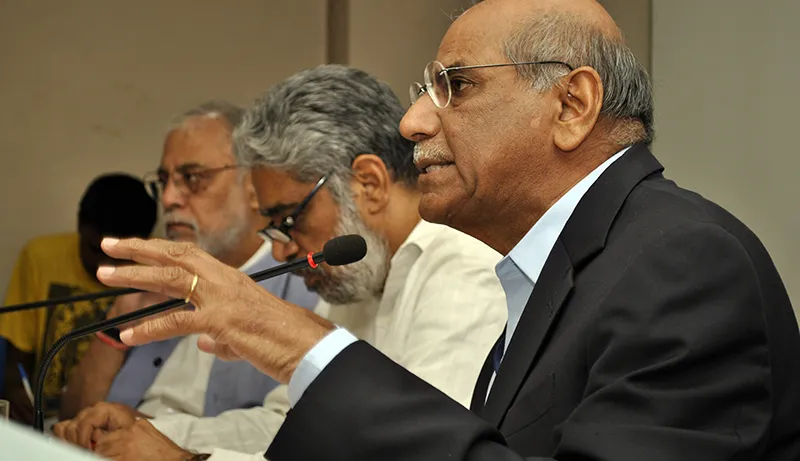The nature of nuclear threat that India faces is not "binary" as India's concerns related with Pakistan and China are intertwined. The history behind China-Pakistan nuclear collusion makes it important to look into the "interlink".

The nature of nuclear threat that India faces is not "binary" as India’s concerns related with Pakistan and China are intertwined. The history behind China-Pakistan nuclear collusion makes it important to look into the "interlink".
This point was underlined during a workshop organised on Agust 5 by the National Security Initiative of Observer Research Foundation to discuss issues related to the various aspects of India’s nuclear doctrine, and address regional concerns sparked by the changing profile of the Pakistani nuclear arsenal and Chinese nuclear posture.
During the first session, chaired by Dr. C Raja Mohan, former Foreign Secretary Shyam Saran explored in detail the subject of "India’s nuclear doctrine: The current issues". In the following session, chaired by Dr. Manoj Joshi, Jawaharlal Nehru University Professor Rajesh Rajagopalan elucidated "Nuclear Doctrines: Global Trends".
During the discussion on India’s nuclear doctrine, speakers and discussants examined issues such as the declaration of India’s nuclear doctrine, the credibility of the doctrine vis-à-vis nuclear deterrence, the nature of threat India faces today and whether or not the doctrine requires any changes. The discussion also focused on the introduction of Tactical Nuclear Weapons (TNWs) by Pakistan and how it does or does not affect the capacity to deter use of this category of nuclear weapons.
In response to the argument that India’s doctrine failed in deterring the Kargil War, the speaker and the discussants acknowledged the fact that India’s nuclear doctrine was not developed to deter conventional war, and its only focus was on deterring a nuclear first strike. It is essentially why India adopted the policy of No First Use (NFU). While discussing the implications of TNWs, it was acknowledged that in the India-Pakistan context, the distinction between strategic and tactical weapons is "blurred". At some level these distinctions become merely "academic," as for practitioners there is no relevance of such differentiations. It was also noted that the Cold War doctrines like "flexible response" and "graduated response" are not applicable in the Indian case. Speaking about safety and security of India’s nuclear arsenal, it was argued that India’s nuclear arsenal is among the smallest in the world and India has taken steps to promote its safety and security.
The following session took in a wider view of nuclear doctrines from around the globe. The nuclear doctrines were broadly categorised on the basis of their driving factors. Israel and Pakistan were categorised as states whose nuclear doctrines were based on the survivability of the state. It was argued that both the states were conventionally weaker than the threats they faced. While Israel’s doctrine focuses on the threat faced by the Arab states, Pakistan’s doctrine is premised on the threat that it faces from India. It was, however, argued in the case of Pakistan, that it may have constructed the threat to its survival to justify its escalatory nuclear doctrine. However, the key distinction between the doctrines of the two nuclear powers was that while Israel’s was worried about survival in the long run and concerned with long term threats, Pakistan, conventionally a much weaker state was concerned with immediate threats.
States like Russia, on the other hand, were not worried about their survivability and their nuclear rhetoric, sparked by conventional inferiority, was but a "knee-jerk" reaction. The focus of the US forces was national retaliation strategy. It was also noted that for states like India and China, survival was not a concern and that their insecurities are much lower than that of Israel and Pakistan. China has been insecure about Japan and the US. However, the development of its nuclear arsenal and missile defence systems highlight the fact that China sees these weapons as political tools, useful only for "nuclear retaliation" rather than "nuclear fighting". The deterrence logic of the British and French doctrines was argued to be not very clear as the two did not have any adversaries which imminently threatened them. The lack of clarity in their nuclear doctrines was because of the lack of a defined threat. In the Indian case, issues related to the Cold Start, structure of nuclear arsenal, political apathy to a doctrine and the prospect of military involvement in the process of devising a nuclear doctrine were examined.
During the concluding question and answer session important issues like that of the difference between strategy, policy and doctrine, the paradox of how the doctrines are formed and the difference between declared and practiced doctrine were discussed in detail. Dr WPS Sidhu, Ambassador Arundhati Ghose, R. Admiral K. Raja Menon, Professor Vipin Narang, Admiral Arun Prakash and several other eminent practitioners, academics, scholars and journalists participated and contributed to the discussion.
(This report is prepared by Rishika Chauhan, Junior Fellow, Observer Research Foundation, Delhi)
The views expressed above belong to the author(s). ORF research and analyses now available on Telegram! Click here to access our curated content — blogs, longforms and interviews.




 PREV
PREV

